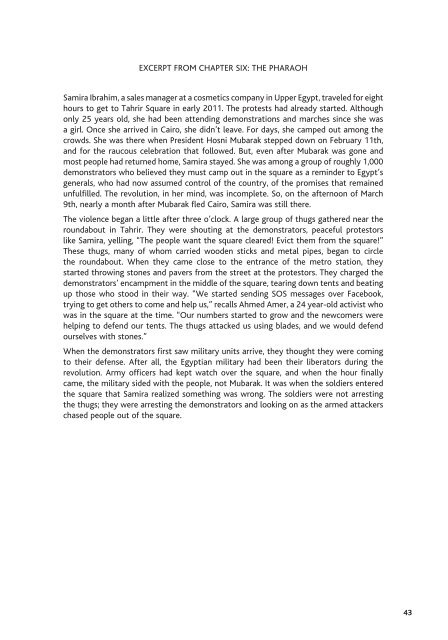Create successful ePaper yourself
Turn your PDF publications into a flip-book with our unique Google optimized e-Paper software.
EXCERPT FROM CHAPTER SIX: THE PHARAOH<br />
Samira Ibrahim, a sales manager at a cosmetics company in Upper Egypt, traveled for eight<br />
hours to get to Tahrir Square in early 2011. <strong>The</strong> protests had already started. Although<br />
only 25 years old, she had been attending demonstrations and marches since she was<br />
a girl. Once she arrived in Cairo, she didn’t leave. For days, she camped out among the<br />
crowds. She was there when President Hosni Mubarak stepped down on February 11th,<br />
and for the raucous celebration that followed. But, even after Mubarak was gone and<br />
most people had returned home, Samira stayed. She was among a group of roughly 1,000<br />
demonstrators who believed they must camp out in the square as a reminder to Egypt’s<br />
generals, who had now assumed control of the country, of the promises that remained<br />
unfulfilled. <strong>The</strong> revolution, in her mind, was incomplete. So, on the afternoon of March<br />
9th, nearly a month after Mubarak fled Cairo, Samira was still there.<br />
<strong>The</strong> violence began a little after three o’clock. A large group of thugs gathered near the<br />
roundabout in Tahrir. <strong>The</strong>y were shouting at the demonstrators, peaceful protestors<br />
like Samira, yelling, “<strong>The</strong> people want the square cleared! Evict them from the square!”<br />
<strong>The</strong>se thugs, many of whom carried wooden sticks and metal pipes, began to circle<br />
the roundabout. When they came close to the entrance of the metro station, they<br />
started throwing stones and pavers from the street at the protestors. <strong>The</strong>y charged the<br />
demonstrators’ encampment in the middle of the square, tearing down tents and beating<br />
up those who stood in their way. “We started sending SOS messages over Facebook,<br />
trying to get others to come and help us,” recalls Ahmed Amer, a 24 year-old activist who<br />
was in the square at the time. “Our numbers started to grow and the newcomers were<br />
helping to defend our tents. <strong>The</strong> thugs attacked us using blades, and we would defend<br />
ourselves with stones.”<br />
When the demonstrators first saw military units arrive, they thought they were coming<br />
to their defense. After all, the Egyptian military had been their liberators during the<br />
revolution. Army officers had kept watch over the square, and when the hour finally<br />
came, the military sided with the people, not Mubarak. It was when the soldiers entered<br />
the square that Samira realized something was wrong. <strong>The</strong> soldiers were not arresting<br />
the thugs; they were arresting the demonstrators and looking on as the armed attackers<br />
chased people out of the square.<br />
43






